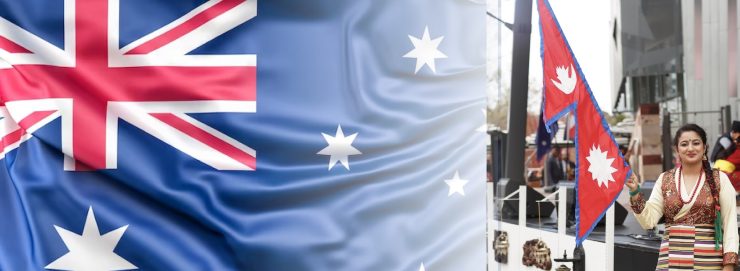Abstract
Australia’s multicultural mosaic is a canvas painted with narratives from around the world, each thread contributing to the rich tapestry of the nation’s heritage. Among these stories, the Nepalese community’s journey serves as a testament to resilience, unity, and cultural celebration. This article chronicles the remarkable transformation of this community over the past decade, providing insights into its demographic dynamics, diplomatic relations, and its significant role in shaping Australia’s socio-economic landscape. Employing data from reputable sources, such as the Australian Bureau of Statistics and the Department of Home Affairs, this article adheres to scholarly conventions of citation, offering a comprehensive exploration of the Nepalese community’s voyage in Australia.
Introduction: A Living Textile of Diversity
In the heart of Australia’s multicultural montage, the Nepalese community’s narrative stands as a remarkable evidence to the enduring bonds of time, growth, and shared connections. This is a story of resilience, unity, and cultural celebration that has transformed the Nepalese community into one of the fastest-growing immigrant populations across the vast Australian continent.
An Epic Journey of Transformation: From Modesty to Magnitude
Our tale begins in the 1960s when the first whispers of Nepalese migration touched the Australian shores (Migration Museum, 2023). The journey was modest in its infancy, with just a handful of individuals seeking new beginnings in a distant land. Yet, recent years have witnessed a transformation that can only be described as extraordinary. In particular, the last decades have been an evidence to this phenomenon. The Nepalese community has surged from a mere 3,800 individuals in 2005 to a thriving community of more than 43,500 in just ten years. In June 2020, the Australian landscape bore witness to the presence of 131,830 Nepalese-born individuals, representing a fivefold increase from the 27,200 recorded in 2010 (Chang & Maunder, 2022). The rapid growth and integration of the Nepali community continue to be a source of inspiration and shared pride.
Diplomatic Ties: A Milestone in 2023
Diplomatic relations between Nepal and Australia were established on February 15, 1960. In a tribute to the depth of this partnership, Australia and Nepal celebrated a significant milestone in 2023 by marking 63 years of diplomatic relations. This longstanding relationship is rooted in a history of development collaboration and robust people-to-people connections (Embassy of Nepal in Canberra, 2023). There are offices of Honorary Consul General in Sydney, Melbourne, Adelaide and Perth to assist with the consular services provided by the government of Nepal.
Education Hub: Nepali Students Flock to Australia
Australia is not only a destination for Nepali migrants but has also emerged as the preferred choice for Nepali students. In 2022, more than 55,000 Nepali international students pursued their dreams through education in Australia, reaffirming the nation’s position as an educational hub (Department of Foreign Affairs and Trade, 2023).
A Hand of Support Beyond Borders
Australia’s commitment to Nepal goes beyond migration and education. In the fiscal year 2022-23, Australia is set to provide approximately $26.6 million in official development assistance to Nepal (Department of Foreign Affairs and Trade, 2023). This support encompasses initiatives to strengthen Nepal’s response to ongoing challenges, particularly the relentless battle against COVID-19, aligned with the comprehensive COVID-19 Response Plan for Nepal, which fits seamlessly into the Partnerships for Recovery Strategy.
Australia’s steadfast partnership with Nepal transcends the ordinary. In times of crisis, Australia has extended a helping hand to Nepal, offering vital food assistance during the 2020 monsoon floods and landslides. The nation has also poured in over $28 million in relief following the devastating earthquakes in 2015 (Department of Foreign Affairs and Trade, 2023).
A Friendship Forged in Time: Diplomatic Ties That Endure
The diplomatic ties between Nepal and Australia, initiated in 1960, have evolved into a lasting friendship, characterized by mutual understanding. This enduring relationship has served as a catalyst for a burgeoning exchange of culture and economic and technical cooperation between the two nations.
The foundation of Australia’s connection with Nepal remains development assistance and strong people-to-people bonds established through tourism and education. As of June 2021, the Nepalese-born population in Australia reached 129,870, marking them as the eleventh largest migrant community, contributing to 1.7% of the overseas-born population and 0.5% of the entire Australian populace (Department of Home Affairs, 2023).
The Beauty of Diversity: A Young and Balanced Demography
The Nepalese-born community in Australia paints a picture of diversity and balance. The median age of Nepalese-born individuals residing in Australia is a youthful 28.8 years, notably younger than the general population. This demographic is balanced, with a slight predominance of males at 54.1% and females at 45.9% (Department of Home Affairs, 2023). The harmonious blend of cultures and talents mirrors a partnership of heritage and promise.
Permanent Migration: Weaving Australia’s Diversity
In the colorful needle point of Australia’s permanent migration program, we find a harmonious blend of dreams and opportunities across various streams. These streams symbolize Australia’s commitment to embracing talent and family, honoring its past, and celebrating a shared journey.
Skill Stream: Nepalese professionals, from IT experts to healthcare professionals, find a welcoming home to contribute to Australia’s thriving economy. With aspirations of economic growth, Nepalese professionals find their place in the Skill stream. This category welcomes those who possess skills, qualifications, and entrepreneurship vital for Australia’s flourishing economy. Whether it’s through the Global Talent (Independent) visa, State/Territory Nominated, or Skilled Independent pathway, Nepalese talent becomes an integral part of Australia’s future.
Family and Child Stream: For Nepalese families, the Family stream offers the chance to reunite and cherish the joy of being together with close family members who are Australian citizens, permanent residents, or eligible New Zealand citizens. It extends its embrace to partners, parents, children, and even aged dependent relatives, carers, remaining relatives, and orphan relatives, fostering a sense of togetherness.
The numbers reveal a heartwarming trend. Year by year, more Nepalese individuals find their new homes in Australia through the Skill stream, particularly the State/Territory Nominated category. The bonds of partnership, family, and kinship continue to strengthen the enduring connection between Australia and Nepalese migrants.
Temporary Migration:
- Temporary migration to Australia is for various purposes, including tourism, study, skilled work, and working holidays.
- Visitor visas are commonly used for tourism and short-term business activities.
- The Working Holiday Maker Program allows young adults to have extended holidays and engage in short-term work and study.
- Student visas enable international students to study full-time in registered courses in Australia.
- The Temporary Resident (Skilled Employment) visa allows businesses to sponsor skilled overseas workers.
- Temporary migration statistics are provided for international student visa grants and Temporary Resident (Skilled Employment) visa grants.
Main Occupations:
The main occupations for Nepalese-born migrants in Australia based on Skill stream migration outcomes and Temporary Resident (Skilled Employment) visa grants.
Common occupations include chefs, registered nurses, cooks, accountants, software and applications programmers, and others.
Geographic Distribution:
Nepalese-born migrants in Australia, both in the population as a whole, and among permanent and temporary migrants are distributed all over Australia.
New South Wales (NSW) has the highest concentration of Nepalese-born migrants, followed by Victoria (VIC) (Australian Bureau of Statistics, 2021).
As of the 2021 Census, here are the numbers and percentages of Nepalese-born migrants in various states and territories of Australia:
New South Wales (NSW): 53% of Nepalese-born migrants.
Victoria (VIC): 16% of Nepalese-born migrants.
Queensland (QLD): 9% of Nepalese-born migrants.
South Australia (SA): 6% of Nepalese-born migrants.
Western Australia (WA): 4% of Nepalese-born migrants.
Tasmania (TAS): 5% of Nepalese-born migrants.
Northern Territory (NT): 2% of Nepalese-born migrants.
Australian Capital Territory (ACT): 5% of Nepalese-born migrants (Australian Bureau of Statistics, 2021).
These percentages reflect the distribution of Nepalese-born migrants across the various states and territories in Australia as of 2021. Please note that these numbers can change over time due to migration trends.
Country Ranking
The significance of Nepalese migration to Australia over the past four financial years. It looks at different aspects, including the overall population of Nepalese-born individuals in Australia, various migration streams, and the number of temporary visitors. Let’s break down the details of each category:
- Population in Australia:
- In 2018-19, Nepalese-born individuals in Australia were ranked 17th based on their population.
- In 2019-20, the ranking improved to 11th.
- In 2020-21, it remained 11th.
- In 2021-22, the ranking continued at 11th (Department of Home Affairs, 2023).
- These rankings are based on the estimated population of Nepalese-born individuals in Australia at the end of each financial year.
- Skill Stream Migration:
- The Skill Stream focuses on skilled workers needed in the Australian economy.
- In 2018-19, Nepalese migration was ranked 6th in the Skill Stream category.
- The ranking remained at 6th in 2019-20.
- It improved to 5th in 2020-21.
- In 2021-22, the ranking further improved to 3rd (Department of Home Affairs, 2023).
- This indicates the growing importance of Nepalese migrants in the Australian workforce, particularly in skilled occupations.
- Family and Child Stream Migration:
- The Family and Child Stream includes family members of Australian citizens and permanent residents.
- In 2018-19, the ranking for Nepalese migration in this stream was 21st.
- In 2019-20, it slipped to 27th.
- In 2020-21, the ranking improved to 23rd.
- In 2021-22, it remained at 24th (Department of Home Affairs, 2023).
- This shows that while Nepalese family reunification migration exists, it is not as prominent as the Skill Stream migration.
- International Students:
- This category reflects the significance of Nepalese international students in Australia.
- In all four financial years (2018-19 to 2021-22), Nepalese migration was consistently ranked 3rd in terms of international students (Department of Home Affairs, 2023).
- This highlights that a large number of Nepalese students choose Australia for their higher education.
- Temporary Resident (Skilled Employment) Visa:
- This category indicates the significance of temporary skilled workers from Nepal.
- In 2018-19, Nepalese migration was ranked 16th in this category.
- The ranking remained 16th in 2019-20.
- It improved slightly to 19th in 2020-21.
- In 2021-22, the ranking remained at 16th (Department of Home Affairs, 2023).
- This suggests that there’s a consistent presence of Nepalese temporary skilled workers in Australia.
- Visitors:
- This category reflects the number of Nepalese visitors to Australia.
- In 2018-19, the ranking was 27th.
- In 2019-20, it remained 26th.
- It improved to 10th in 2020-21.
- In 2021-22, the ranking was 14th (Department of Home Affairs, 2023).
- This indicates that the number of Nepalese visitors to Australia increased significantly in 2020-21 but remained relatively high in 2021-22.
These rankings provide a comprehensive overview of the significance of Nepalese migration to Australia in various categories over the specified financial years. It demonstrates the growing presence of Nepalese individuals in Australia, particularly in skilled occupations and as international students.
Australia’s evolving relationship with Nepal is a testament to remarkable growth, enduring partnership, and shared potential. This multicultural journey showcases the transformative power of connections, with the Nepalese community adding vibrancy and vitality to Australia. As we look ahead, the future is bright, built on understanding and collaboration, embodying the spirit of unity in diversity.
References:
Australian Bureau of Statistics. (2021). Country of birth of person (BPLP). https://www.abs.gov.au/census/guide-census-data/census-dictionary/2021/variables-topic/cultural-diversity/country-birth-person-bplp
Chang, C. & Maunder, S. (2022). This is Australia’s fastest-growing migrant community. SBS News. https://www.sbs.com.au/news/article/this-is-australias-fastest-growing-migrant-community/qns2roccp
Department of Foreign Affairs and Trade. (2023). Nepal country brief. https://www.dfat.gov.au/geo/nepal/nepal-country-brief
Department of Home Affairs. (2023). Permanent migration from Nepal. https://www.homeaffairs.gov.au/research-and-statistics/statistics/country-profiles/profiles/nepal
Embassy of Nepal in Canberra. (2023). Nepal-Australia relations. https://au.nepalembassy.gov.np/bilateral-relations/
Migration Museum. (2023). Nepalese in South Australia. SA History Hub, History Trust of South Australia. https://sahistoryhub.history.sa.gov.au/subjects/nepalese-in-south-australia
















Add comment